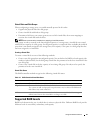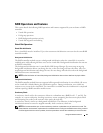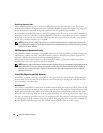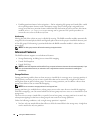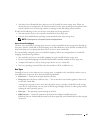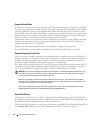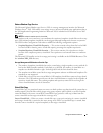
42 Using Your RAID Enclosure
Disk Group Operations Limit
The maximum number of active, concurrent disk group processes per controller is one. This limit is
applied to the following disk group processes: virtual disk RAID level migration, segment size migration,
virtual disk capacity expansion, disk group expansion, and disk group defragmentation.
If a redundant controller fails with an existing disk group process, the process on the failed controller is
transferred to the peer controller. A transferred process is placed in a suspended state if there is an active
disk group process on the peer controller. The suspended processes is resumed when the active process
on the peer controller completes or is stopped.
NOTE: If you try to start a disk group process on a controller that does not have an existing active process, the
start attempt will fail if the first virtual disk in the disk group is owned by the other controller and there is an active
process on the other controller.
RAID Background Operations Priority
The controller supports a common configurable priority for the following RAID operations: background
initialization, rebuild, copy back, virtual disk capacity expansion, RAID level migration, segment size
migration, disk group expansion, and disk group defragmentation.
The priority of each of these operations can be changed to address performance requirements of the
environment in which the operations are to be executed.
NOTE: Setting a high priority level will impact storage array performance. It is not advisable to set priority levels at
the maximum level. Priority should also be assessed in terms of impact to host access and time to complete an
operation. For example, the longer a rebuild of a degraded virtual disk takes, the greater the risk for potential
secondary disk failure.
Virtual Disk Migration and Disk Roaming
Virtual disk migration is moving a virtual disk or a hot spare from one array to another by detaching the
physical disks and re-attaching them to the new array. Disk roaming is moving a physical disk from one
slot to another on the same array.
Disk Migration
You can move virtual disks from one array to another without taking the target array offline. However, the
disk group being migrated must be offline prior to performing the disk migration. If the disk group is not
offline prior to migration, the source array holding the physical and virtual disks within the disk group
will mark them as missing. However, the disk groups themselves will still be migrated to the target array.
An array can import a virtual disk only if it is in an optimal state. You can move virtual disks that are part
of a disk group only if all members of the disk group are being migrated. The virtual disks automatically
become available after the target array has finished importing all the disks in the disk group.




